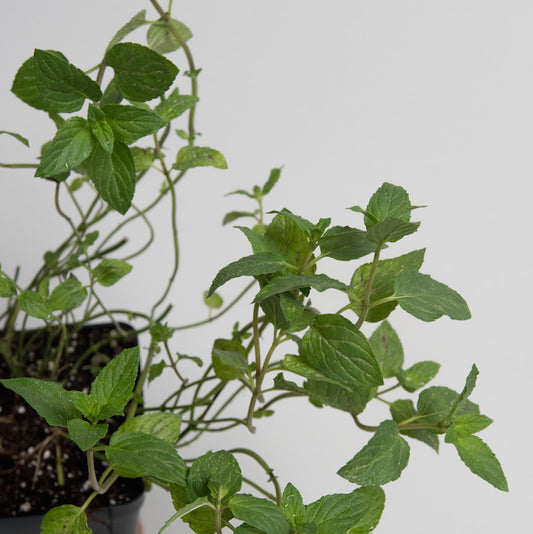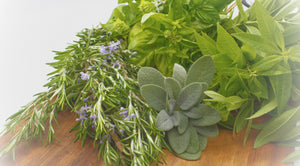Mint plants are a group of aromatic herbs that belong to the genus Mentha, having square stems, opposite leaves and small blooms that grow in clusters. The plant's main claim to popularity is the strong yet refreshing flavor and aroma of its leaves.
Mint has a long and fascinating history and was widely used throughout Europe, Asia and North America. The ancient Greeks and Romans used the herb to freshen their breath, flavor their food and treat various ailments. In medieval Europe, the plant was believed to ward off evil spirits and was also utilized as a strewing grass to freshen the air in homes and churches.
Today, mint is still extensively used for its culinary and medicinal properties and is a popular addition to gardens and landscapes. It is a low-maintenance plant that can be grown in containers or directly in the ground.
Mint is a natural pest repellent that helps keep insects and rodents away. It also attracts pollinators like bees and butterflies, ensuring the production of fruits, vegetables and flowers, which are essential for the growth and survival of the plants.
With its many benefits, it's easy to see why mint plants are famous for gardeners of all skill levels.
The Different Types of Mint Plants
Did you know that there are over 600 different species of mint plants, each with its unique characteristics and uses? Below, we explore the six most common variations of this aromatic and flavorful herb.
Peppermint is one of the most prevalent mint types known for its intense flavor. When eaten, it leaves a cooling and refreshing sensation that lingers in the mouth. This is because peppermint contains a higher menthol concentration, giving it its characteristic aroma and taste.
Like other variations of mint, spearmint is utilized in various applications, including culinary, medicinal and aromatherapy. However, it has a milder and sweeter taste, with a less pronounced menthol content when compared to peppermint. Spearmint is often added to teas, salads and desserts.
Chocolate mint, as the name suggests, has a distinct chocolate flavor and aroma. Its leaves are dark green with a hint of purple, often used in desserts, teas and cocktails. Compared to other mint varieties, chocolate is a more compact plant, growing to only one to two feet tall.
Mojito mint has a more traditional flavor and is commonly added to the classic Cuban cocktail, the mojito. Its leaves are a bright green and slightly larger than other mint variations. Mojito mint plants can grow up to three to four feet tall and have a more sprawling growth habit.
Orange mint is famous for its citrus taste, making it a delicious addition to cocktails and desserts. It has bright green leaves with a slightly fuzzy texture, and the plant can grow up to two feet tall. Orange mint is the variety that attracts the most bees and butterflies, which makes them a beneficial addition to any garden.
Mountain mint possesses a strong, pungent taste with a hint of menthol. It is used as an ingredient for savory dishes and an addition to herbal teas. The plant is also popular for its medicinal properties and is used to treat digestive issues and headaches. Mountain mint plants with gray-green wooly leaves can grow up to three feet tall.
FAQs About Mint Plants
Q: Does mint need full sun?
A: Mint plants are best planted in spring and prefer full sun to partial shade. It's essential to provide them with at least four to six hours of sunlight daily to promote healthy growth. If you're growing mint indoors, place the pot near a sunny window or under grow lights to ensure they receive enough light.
Q: Can I plant mint in pots?
A: Mint plants can be grown directly on the ground and in pots. If you have limited space or want to control its growth, placing them in containers is an excellent option. They quickly spread and take over the garden space, so it's best to plant them in individual pots or with other herbs that can tolerate their growth habit.
Q: Can I contain mint plants with steel edging?
A: Steel edging is a great way to contain mint plants and prevent them from spreading too far. The herb is a vigorous grower and can quickly take over a garden bed if left unchecked. So, you can install the steel edging around the bed's perimeter to create a physical barrier preventing the plants from spreading beyond their designated area.
Q: Do I need to fertilize mint plants?
A: Mint is a relatively low-maintenance plant that doesn't require much fertilization. However, it can benefit from light feeding once or twice during the growing season. Use a fertilizer with equal amounts of nitrogen, phosphorus and potassium, then apply it at half the recommended strength since over-fertilizing may lead to excessive growth.
Q: Where to buy mint plants?
A: Knowing where to buy mint plants helps ensure you get high-quality herbs that have been well-cared for and are likely to thrive in your garden. Look for sellers with a track record of success and positive customer feedback. Another factor to consider when looking for peppermint plants for sale is the merchant's experience selling herbs.
Ideally, you want to find a seller who has been in the business for several years and deeply understands the plant's needs and requirements. This ensures that you receive expert guidance on caring for your mint plant and gives you access to a wide range of varieties.
Explore our selection if you are looking for peppermint plants for sale online.

 Sold out
Sold out
 Sold out
Sold out
 Sold out
Sold out
 Sold out
Sold out
 Sold out
Sold out




















